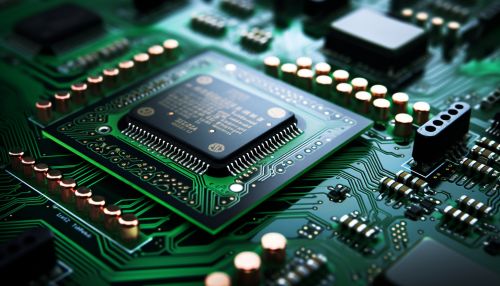Embedded system
Introduction
An embedded system is a computer system—a combination of a computer processor, computer memory, and input/output peripheral devices—that has a dedicated function within a larger mechanical or electrical system. It is embedded as part of a complete device often including electrical or electronic hardware and mechanical parts. Because an embedded system typically controls physical operations of the machine that it is embedded within, it often has real-time computing constraints. Embedded systems control many devices in common use today.


Architecture
Embedded systems are typically produced on broad scales and share functionalities across a variety of environments and applications. Therefore, embedded systems often have a layered architecture. The layers of an embedded system are:
1. The hardware layer: This layer encompasses the microprocessor and microcontroller which includes embedded software. The embedded software layer consists of the kernel, real-time operating system (RTOS), and the hardware abstraction layer.
2. The firmware layer: This layer interacts with the hardware layer via the hardware abstraction layer. It includes device drivers and embedded operating systems.
3. The application software layer: This layer executes standard software commands that are not executed directly by the hardware layer.
Classification
Embedded systems can be classified into different types based on performance and functional requirements:
1. Real-time systems: These systems follow the real-time constraints of completion of work and react to events. They can be further divided into soft and hard real-time systems.
2. Stand-alone systems: These systems take inputs, process them, and generate outputs. The input can be electrical signals or user commands, and the output can be electrical signals or an interface message.
3. Networked Information Devices or Systems on Chip (SoCs): These embedded systems are part of a network to provide real-time control. They share information with other networking devices and require an interface to connect to the network.
4. Mobile systems: These systems are designed to be portable.
Characteristics
Embedded systems are designed to perform a dedicated function or functions. Key characteristics include:
1. Single-functioned: An embedded system usually executes a specific program repeatedly.
2. Tightly constrained: All computing systems have constraints on design metrics, but those on an embedded system can be particularly tight.
3. Reactive and real-time: Many embedded systems must continually react to changes in the system's environment and must compute certain results in real time without delay.
Design Considerations
Designing an embedded system can be a complex task. It involves the integration of various components, all of which must work together seamlessly. Key considerations include:
1. System performance: The system must be able to process data in real-time without buffering delays.
2. Power consumption: For handheld devices, battery life is a critical concern. Power-efficient design is a key consideration in such cases.
3. Cost: The cost of the components and system should be kept low.
4. Size: The system should be compact.
5. Reliability: The system should be reliable, able to handle any errors that occur and recover from them.
6. Flexibility: The system should be flexible enough to handle future system upgrades.
Applications
Embedded systems are used in various applications including:
1. Home appliances: washing machines, microwave ovens, refrigerators, and air conditioners.
2. Office automation: printers, scanners, keyboards, and routers.
3. Medical equipment: cardiac monitors, dialysis machines, and digital thermometers.
4. Industrial automation: assembly lines, CNC machines, and digital meters.
5. Automobiles: anti-lock braking systems, airbag controller, and car infotainment systems.
6. Telecommunications: mobile phones, switches, routers, and modems.
Future Trends
The future of embedded systems is likely to be influenced by advancements in technology such as:
1. Internet of Things (IoT): Embedded systems form the backbone of IoT devices. As IoT continues to grow, the demand for advanced and connected embedded systems is also expected to rise.
2. Artificial Intelligence (AI) and Machine Learning (ML): AI and ML capabilities are increasingly being integrated into embedded systems to enable advanced features like predictive maintenance, anomaly detection, and autonomous operation.
3. Cyber-Physical Systems (CPS): These are engineered systems that are built from, and depend upon, the seamless integration of computational algorithms and physical components.
